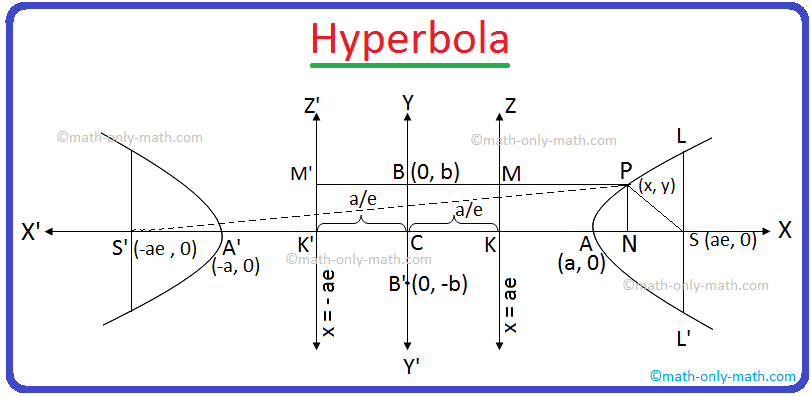Subscribe to our ▶️ YouTube channel 🔴 for the latest videos, updates, and tips.
Standard Equation of an Hyperbola
We will learn how to find the standard equation of a hyperbola.
Let S be the focus, e (> 1) be the eccentricity and line KZ its directrix of the hyperbola whose equation is required.
From the point S draw SK perpendicular to the directrix KZ. The line segment SK and the produced SK divides internally at A and externally at A’ respectively in the ratio e : 1.
Then,
\(\frac{SA}{AK}\) = e : 1
⇒ SA = e ∙ AK …………. (ii)
and \(\frac{SA'}{A'K}\) = e : 1
⇒ SA' = e ∙ A'K …………………. (ii)
The points A and A' he on the required hyperbola because
according to the definition of hyperbola A and A’are such points that their
distance from the focus bear constant ratio e (>1) to their respective
distance from the directrix, therefore A and A' he on the required hyperbola.
Let AA’ = 2a and C be the mid-point of the line segment AA'. Therefore, CA = CA' = a.
Now draw CY perpendicular to AA’ and mark the origin at C. CX and CY are assumed as x and y-axes respectively.
Now, adding the above two equations (i) and (ii) we have,
SA + SA' = e (AK + A'K)
⇒ CS - CA + CS + CA' = e (AC - CK + A’C + CK)
⇒ CS - CA + CS + CA' = e (AC - CK + A’C + CK)
Now put the value of CA = CA' = a.
⇒ CS - a + CS + a = e (a - CK + a + CK)
⇒2CS = e (2a)
⇒ 2CS = 2ae
⇒ CS = ae …………………… (iii)
Now, again subtracting above two equations (i) from (ii) we have,
⇒ SA' - SA = e (A'K - AK)
⇒ AA'= e {(CA’ + CK) - (CA - CK)}
⇒ AA' = e (CA’ + CK - CA + CK)
Now put the value of CA = CA' = a.
⇒ AA' = e (a + CK - a + CK)
⇒ 2a = e (2CK)
⇒ 2a = 2e (CK)
⇒ a = e (CK)
⇒ CK = \(\frac{a}{e}\) ………………. (iv)
Let P (x, y) be any point on the required hyperbola and from P draw PM and PN perpendicular to KZ and KX respectively. Now join SP.
According to the graph, CN = x and PN = y.
Now form the definition of hyperbola we get,
SP = e ∙ PM
⇒ Sp\(^{2}\)= e\(^{2}\)PM\(^{2}\)
⇒ SP\(^{2}\) = e\(^{2}\)KN\(^{2}\)
⇒ SP\(^{2}\) = e\(^{2}\)(CN - CK)\(^{2}\)
⇒ (x - ae)\(^{2}\) + y\(^{2}\) = e\(^{2}\)(x - \(\frac{a}{e}\))\(^{2}\), [From (iii) and (iv)]
⇒ x\(^{2}\) - 2aex + (ae)\(^{2}\) + y\(^{2}\) = (ex - a)\(^{2}\)
⇒ (ex)\(^{2}\) - 2aex + a\(^{2}\) = x\(^{2}\) - 2aex + (ae)\(^{2}\) + y\(^{2}\)
⇒ (ex)\(^{2}\) - x\(^{2}\) - y\(^{2}\) = (ae)\(^{2}\) - a\(^{2}\)
⇒ x\(^{2}\)(e\(^{2}\) - 1) - y\(^{2}\) = a\(^{2}\)(e\(^{2}\) - 1)
⇒ \(\frac{x^{2}}{a^{2}}\) - \(\frac{y^{2}}{a^{2}(e^{2} - 1)}\) = 1
We know that a\(^{2}\)(e\(^{2}\) - 1) = b\(^{2}\)
Therefore, \(\frac{x^{2}}{a^{2}}\) - \(\frac{y^{2}}{b^{2}}\) = 1
For all the points P (x, y) the relation \(\frac{x^{2}}{a^{2}}\) - \(\frac{y^{2}}{b^{2}}\) = 1 satisfies on the required hyperbola.
Therefore, the equation \(\frac{x^{2}}{a^{2}}\) - \(\frac{y^{2}}{b^{2}}\) = 1 represents the equation of the hyperbola.
The equation of a hyperbola in the form of \(\frac{x^{2}}{a^{2}}\) - \(\frac{y^{2}}{b^{2}}\) = 1 is known as the standard equation of the hyperbola.
● The Hyperbola
- Definition of Hyperbola
- Standard Equation of an Hyperbola
- Vertex of the Hyperbola
- Centre of the Hyperbola
- Transverse and Conjugate Axis of the Hyperbola
- Two Foci and Two Directrices of the Hyperbola
- Latus Rectum of the Hyperbola
- Position of a Point with Respect to the Hyperbola
- Conjugate Hyperbola
- Rectangular Hyperbola
- Parametric Equation of the Hyperbola
- Hyperbola Formulae
- Problems on Hyperbola
11 and 12 Grade Math
From Standard Equation of an Hyperbola to HOME PAGE
Didn't find what you were looking for? Or want to know more information about Math Only Math. Use this Google Search to find what you need.



New! Comments
Have your say about what you just read! Leave me a comment in the box below. Ask a Question or Answer a Question.